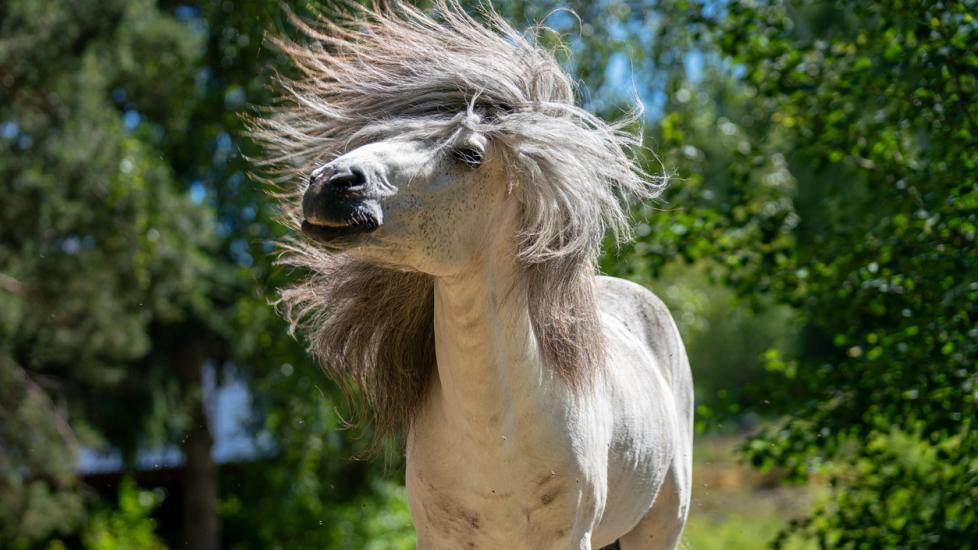Why Do Horses Have Manes?
One of the most alluring and distinctive features of horses is their luxurious mane and tail. Just like people have different hairstyles, horses may have different mane “styles.” Not only are horse manes visually appealing, but they provide multiple functions, including pest control, protection, and a clutch for riders to hold onto in the early days of domestication.
Pest Control for Horses
One function of a horse’s mane is to keep pests away. This is very important because some insects, specifically mosquitoes, can spread life threatening diseases including Eastern Equine Encephalitis and West Nile Virus. Horse flies and deer flies which spread Equine Infectious Anemia, the disease that a Coggins test identifies, can also be swished away by the mane.
The lock of hair that grows from the top of the head and falls forward between the ears onto the forehead is called the forelock. This part of the mane is very helpful in keeping flies out of your horse’s eyes. Some breeds, particularly ponies, have very thick forelocks, whereas other breeds like Thoroughbreds have thin forelocks. Primitive horses like the Przewalski’s horses and donkeys have no discernable forelock.
Protection for Horses
In addition to providing pest control, your horse’s mane provides additional forms of protection. The mane, like wearing a nice insulating scarf, keeps the neck cozy and warm. It also keeps the neck dry in the rain, and the forelock protects the eyes from the sun.
A thick, large mane may make the horse appear bigger and deter an attacker. However, if the predator does attack, the mane can also keep predators from latching onto the neck and internal vital structures. Not only is the neck area attacked by other species, but when stallions fight, they tend to bite at each other’s necks. This is also why stallions tend to have thicker manes than mares.
Marker of Health for Horses
A thick and shiny mane is a sign of good health. A healthy, full mane indicates access to resources and nutrition. Animal behaviorists have also found that mares are more attracted to stallions with a thicker mane. This is because it signifies strength and ability to provide protection.
Is it OK to Cut a Horse's Mane?
Routine grooming is required to keep a mane healthy. Mane maintenance starts by using your fingers to pick out any large debris and separate tangles. In general, having a couple different brushes will be helpful. A soft bristle brush is used at the base of the mane while a mane and tail brush is used for the length. An equine hair conditioner is also very helpful for keeping your horse’s main healthy. Even though in nature a thick mane is desirable, in our companion horses a mane may get too thick and becomes unmanageable.
It is best not to cut your horse’s mane. Instead, to thin out your horse’s mane, use a technique called “pulling.” The key to pulling your horse’s mane is to use short, quick pulls and to work in small sections of the mane. Tease out the long hairs with a mane comb. Starting with the longest hairs will both thin the hair and shorten the length.
When starting to pull your horse’s mane, don’t pull it all at once as this may lead the horse to resent it. Instead, do a small amount at a time and over multiple sessions. This technique should not bother your horse; if it does, ask an experienced horse person for help.
It should be noted that in some cases a horse will have its mane “hogged” or cut short for the entire length. This is often seen in working horses like the Cob and polo horses.
Braided Horse Manes
Another distinctive and refining feature of horse manes is braiding or plaiting them. Braids are used for mane maintenance but also as part of their attire for showing. By convention, the mane should lie on the right side of the horse’s neck. Most of the time in nature, this is how the mane falls. If your horse’s mane does not part to the right side, you can use braids to train the hair.
Different disciplines use different braids for showing and performance. Some braiding techniques include:
- Straight braids: easy way to keep mane clean and tidy
- Running braid: used for horses with longs manes
- Button braids: commonly used in dressage, may give illusion of higher neck crest
- Hunter braids: accentuates neck, keeps mane out of the rider’s way
- Continental braid: decorative pattern
- Western mane banding: allows mane to lie flat on neck, gives illusion of thinner neck
Can Horses Lose Their Manes?
A horse may lose its mane for a few reasons:
-
External parasites: lice or mites will cause horse to scratch which can pull hair out
-
Blanket rubs: irritate hair and create itching
-
Allergies (sweet itch): allergic reaction to saliva in midge flies, causes itchiness and horses to rub out their mane
-
Infection: bacterial or fungal (i.e., ringworm) creates itching
-
Inadequate nutrition: rarely occurs if the horse is on well-balanced diet
-
Toxicity: high selenium in soil (very rare)
-
Medication side effect: ask your veterinarian about any medications your horse is currently on
References
-
Draper, J., Sly, D., & Muir, S. The Ultimate Book of Horse and Rider. 2014.
-
White, Susan. American Association of Equine Practitioners. Hair Loss. 2016.
Featured Image: iStock.com/Binnerstam
